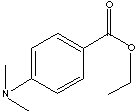PRODUCT IDENTIFICATION

H.S. CODE
TOXICITY
CLASSIFICATION
Amine Photochemical,
EXTRA NOTES
PHYSICAL AND CHEMICAL PROPERTIES
6.7
AUTOIGNITION
NFPA RATINGS
REFRACTIVE INDEX
EXTERNAL LINKS & GENERAL DESCRIPTION
Wikipedia Linking - Photoinitiator
Drug Information Portal (U.S. National Library of Medicine) - Parbenate
PubChem Compound Summary - Ethyl 4-dimethylaminobenzoate
http://www.ebi.ac.uk/ - Parbenate
http://www.ncbi.nlm.nih.gov/ - Ethyl 4-dimethylaminobenzoate
http://www.ncbi.nlm.nih.gov/
Benzoic
acid and its derivatives are good inhibitors of influenza viruses,
For the use of benzoic acid derivatives such as 4-aminobenzoic
acid as bifunctional organic ligands due to the variety of their
coordination modes. For the use of the title compound as a part
of a self-curing two-part system comprising degradable copolymers
with applications in medicine and dentistry as root-canal sealants,
root-canal filling materials, dental restorative materials, implant
materials, bone cements and pulp-capping materials.
Local:
Ethyl-p-dimethylaminobenzoate
is used in curing system in combination with other photoinitiators,
APPEARANCE
ASSAY
WATER
0.2% max
ASH
0.1% max
HAZARD OVERVIEW
Not a dangerous substance according to GHS. May cause eye and skin irritation. May cause respiratory and digestive tract irritation. Target Organs: None.
GHS
PICTOGRAMS
HAZARD STATEMENTS
P STATEMENTS
Not available
RISK PHRASES
SAFETY PHRASES
24/25-28-37